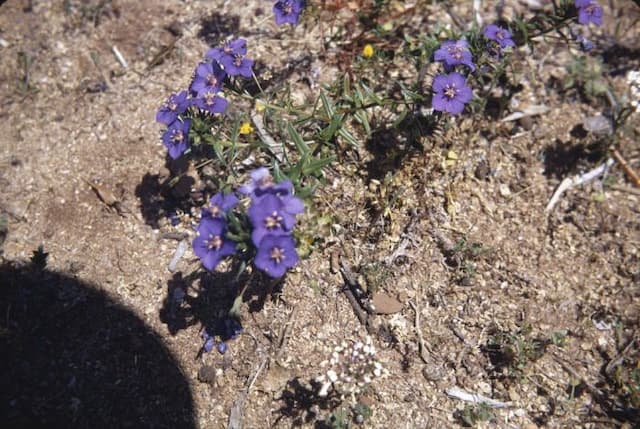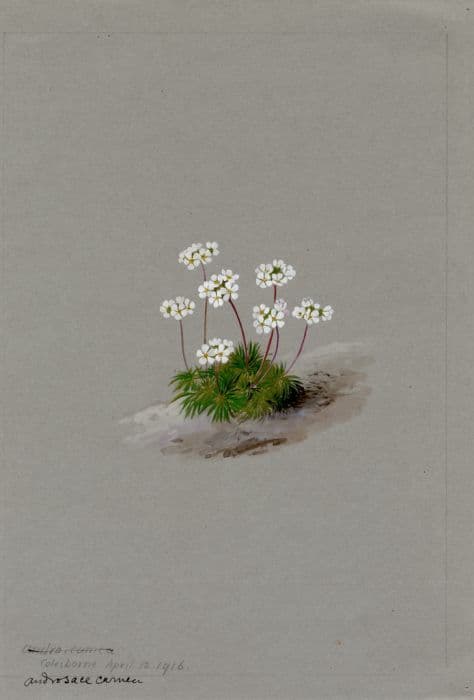Tibetan Cowslip Primula florindae (Si)

ABOUT
Primula florindae, also known as the giant cowslip, features rich green, tongue-shaped leaves that form a lush rosette at the base of the plant. The leaves are characterized by their crinkly texture and sometimes bear a slightly silver hue along their veins. Rising from the center of the foliage, sturdy flower stems emerge, topped with clusters of pendulous, bell-shaped flowers. These blooms, often a vibrant yellow or orange, exquisitely fragrant, hang down in a tiered arrangement much like a delicate chandelier. The charm of the giant cowslip is enhanced by the fine, prominent calyx that envelops the base of each individual flower. This species, with its striking clusters of sweetly scented blooms, adds a touch of bright color and aromatic allure to its surroundings.
About this plant
 Names
NamesFamily
Primulaceae.
Synonyms
Tibetan Cowslip, Giant Cowslip, Himalayan Cowslip.
Common names
Primula florindae.
 Toxicity
ToxicityTo humans
Primula florindae, commonly known as Giant cowslip, is not considered toxic to humans. Therefore, ingesting parts of this plant typically does not lead to poisoning or adverse health consequences.
To pets
Giant cowslip is not considered toxic to pets. Ingesting parts of the plant should not cause poisoning or result in harmful effects for most types of pets. However, any plant material might cause mild stomach upset if consumed in large quantities, but toxicity is not a concern with this particular species.
 Characteristics
CharacteristicsLife cycle
Perennials
Foliage type
Deciduous
Color of leaves
Green
Flower color
Yellow
Height
2 feet (0.6 meters)
Spread
1 foot (0.3 meters)
Plant type
Herb
Hardiness zones
5
Native area
Tibet
Benefits
 General Benefits
General Benefits- Aesthetic Appeal: Adds vibrant yellow color and a unique bell shape to gardens, enhancing visual interest.
- Habitat Enrichment: Offers nectar that attracts pollinators such as bees, butterflies, and birds, supporting local ecosystems.
- Low Maintenance: Requires minimal care once established, making it ideal for gardeners of all skill levels.
- Moisture Indicator: Prefers wet conditions and can be used to indicate areas of the garden that are moist or waterlogged.
- Companion Planting: Can be planted alongside other moisture-loving plants to create lush, water garden settings.
- Erosion Control: Helps stabilize soil in damp areas, reducing erosion and improving soil quality.
- Floral Arrangements: The flowers can be used in fresh bouquets for a fragrant and visually appealing display.
- Seasonal Interest: Blooms in late spring to early summer, providing color during a season when many other plants are not in flower.
- Cultural Significance: May have traditional importance or be used in cultural events, depending on local customs.
- Educational Use: Can be used in botanical studies due to its specific growth requirements and habitat preferences.
 Medical Properties
Medical PropertiesThis plant is not used for medical purposes.
 Air-purifying Qualities
Air-purifying QualitiesThis plant is not specifically known for air purifying qualities.
 Other Uses
Other Uses- Companion Planting: Primula florindae, commonly known as the giant cowslip, can be used in gardens to create aesthetically pleasing plant combinations, particularly in damp or waterside settings.
- Educational Tool: The plant's visible morphological features, such as its large bell-shaped flowers, can be used in educational settings to demonstrate principles of botany and flower structure to students.
- Artistic Inspiration: Artists and photographers may utilize the vibrant colors and unique shape of the giant cowslip as subject matter for artworks, illustrations, and photography projects.
- Culinary Decoration: Although not widely recognized as an edible, the flowers can be used as decorative garnishes for salads and desserts in high-end culinary presentations.
- Fragrance Source: The sweet fragrance of giant cowslip flowers can be used in the production of natural perfumes or in potpourri blends for home fragrance.
- Mood Enhancer: The bright yellow blooms can act as mood enhancers when placed in living or work spaces due to their uplifting color and pleasant fragrance.
- Wildlife Shelter: These plants can provide cover and breeding grounds for small wildlife, like certain insects and amphibians, particularly in their natural moist habitat.
- Soil Erosion Control: Primula florindae can assist in preventing soil erosion around ponds and water bodies due to its clumping habit and root structure.
- Aquatic Garden Focal Point: Primula florindae serves as an attractive focal point in aquatic or bog garden designs due to its height and the visual impact of its pendulous flowers.
- Dye Production: Historically, some Primula species may have been used to produce dyes, and the giant cowslip's flowers could potentially be explored for this use due to their pigmentation.
Interesting Facts
 Feng Shui
Feng ShuiThe Himalayan cowslip is not used in Feng Shui practice.
 Zodiac Sign Compitability
Zodiac Sign CompitabilityThe Himalayan cowslip is not used in astrology practice.
 Plant Symbolism
Plant Symbolism- Hope - Primula florindae, commonly known as Giant Cowslip, often blooms early in the spring, symbolizing hope and the anticipation of things to come.
- New Beginnings - The appearance of its flowers as winter wanes signifies the start of a new cycle of growth and the freshness of spring.
- Youthfulness - With its bright, youthful colors, the Giant Cowslip represents the joy and exuberance of youth.
- Patience - This plant can take a while to establish and bloom, symbolizing the virtue of patience as it grows.
 Water
WaterTibetan primrose should be watered regularly to keep the soil consistently moist, as it prefers a damp environment. Depending on the climate and weather conditions, this might translate to watering once or twice a week. Aim to provide the plant with around 1 to 1.5 gallons of water each time during active growth periods. Be cautious not to overwater, as standing water can lead to root rot. In the winter, reduce watering frequency to match the plant's reduced growth and water needs.
 Light
LightTibetan primrose thrives in partial shade where it can be protected from the intense midday sun. The ideal spot for this plant is in an area that receives morning sunlight followed by dappled shade for the rest of the day. Avoid deep shade, as this can hinder the flowering process—bright, indirect light will encourage the best growth and bloom.
 Temperature
TemperatureTibetan primrose does well in a temperature range of 50 to 70 degrees Fahrenheit. It can tolerate a minimum temperature down to about 32 degrees Fahrenheit but prefers cooler conditions and might not thrive in temperatures above 80 degrees Fahrenheit. The ideal temperature for this plant would be within this cooler range to encourage healthy growth.
 Pruning
PruningPruning Tibetan primrose is mainly done to remove dead or fading flowers and to keep the plant looking tidy. Deadheading spent blooms encourages further flowering. The best time to prune is immediately after flowering has finished. If necessary, you can also cut back foliage in late fall to prepare the plant for winter.
 Cleaning
CleaningAs needed
 Soil
SoilThe Tibetan Primrose thrives best in moist, well-draining soil enriched with organic matter. A mix of peat, loam, and sand is ideal, aiming for a slightly acidic to neutral pH range of 6.0 to 7.0 for optimal growth.
 Repotting
RepottingTibetan Primroses typically require repotting every 1-2 years to replenish nutrients in the soil and provide room for root growth. It's best to repot in the spring before the growing season.
 Humidity & Misting
Humidity & MistingTibetan Primrose prefers high humidity levels, enjoying conditions similar to its native damp habitats. Aim for a humidity level of 75% or higher to maintain healthy growth.
 Suitable locations
Suitable locationsIndoor
Keep Tibetan Primrose in bright, indirect light with high humidity.
Outdoor
Plant Tibetan Primrose in shade, in moist, rich soil.
Hardiness zone
7-9 USDA
 Life cycle
Life cycleTibetan cowslip (Primula florindae) typically begins its life cycle with seed germination, which occurs in moist, well-drained soil in a shady to partially shady environment. Following germination, seedlings emerge and establish a rosette of leaves at the soil surface. As the plant matures, it develops a sturdy root system and begins to produce taller leafy stems. During the blooming period, usually in early to mid-summer, the Tibetan cowslip produces umbels of fragrant, bell-shaped, yellow flowers on tall stalks that can attract pollinators such as bees and butterflies. After pollination, the flowers develop into capsules containing numerous tiny seeds that, once mature, are dispersed by wind, water, or animals. In subsequent seasons, the plant can go through vegetative growth again or may produce offsets that develop into new plants, thus continuing the cycle.
 Propogation
PropogationPropogation time
Spring to early summer
The most popular method of propagation for Primula florindae, commonly known as the Tibetan cowslip, is by sowing seeds. The best time to sow Primula florindae seeds is typically in late winter or early spring when temperatures are cool, which provides a natural stratification process. Gardeners should sprinkle the seeds onto a tray of moist, well-draining soil and just lightly cover them with a thin layer of soil or vermiculite. Ideally, the seeds require light to germinate, so they should not be buried deeply. The tray should be placed in a bright area but out of direct sunlight, and kept at a temperature around 60-70 degrees Fahrenheit (15.5-21 degrees Celsius). Germination usually occurs within 14 to 30 days. After the seedlings have developed their first set of true leaves, they can be transplanted into individual pots and grown on before planting out in the garden once the risk of frost has passed.









